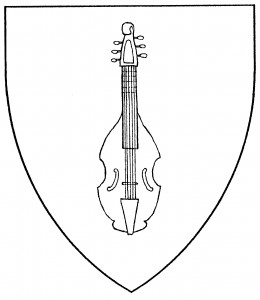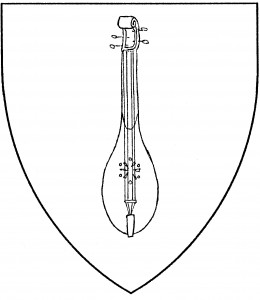A viol is a stringed musical instrument, a medieval cousin of the violin. It had a flat back, a fretted neck, and six strings; it was played with a curved bow. Its “proper” tincture is brown, the color of wood. When blazoned a “violin”, the Renaissance (i.e., modern) form is intended.
The terms “vielle” and “fiddle” are sometimes used to denote this family of instruments; these terms have the advantage of leaving the exact details and period to the artist. By whatever name, the charge can be dated to c.1340, in the arms of Wilfendingen or Wieladingen [Zurich 347].
Similar to the viol is the “rebec”, more pear-shaped, with a rounded back like a lute, and three or four strings. Heraldically, it is indistinguishable from the lute.
Both the viol and the rebec have strings to the viewer by default. The Society default is with neck to chief, contrary to the period default.
Samuel Piper bears: Quarterly vert and Or, four viols counterchanged.
Cedric Fithelere bears: Per fess azure and argent, on a pale engrailed between in chief two violins palewise, in base a violin palewise, all counterchanged.
Rebecca de Ravenstein bears: Vert, a rebec in bend sinister, pegheads in chief, crossed by a bow fesswise argent.

